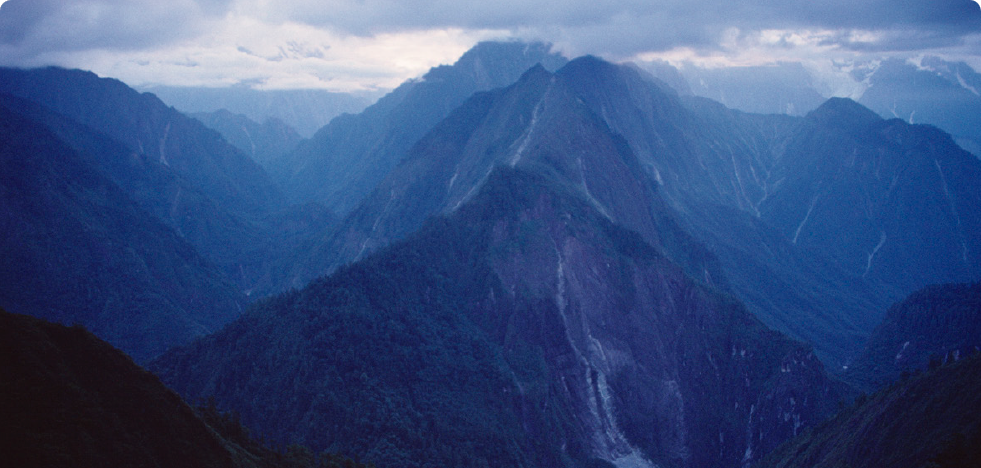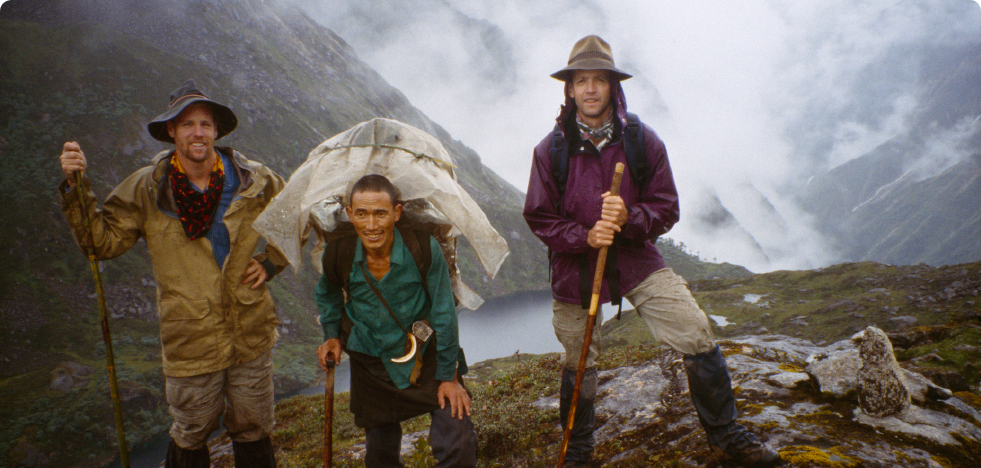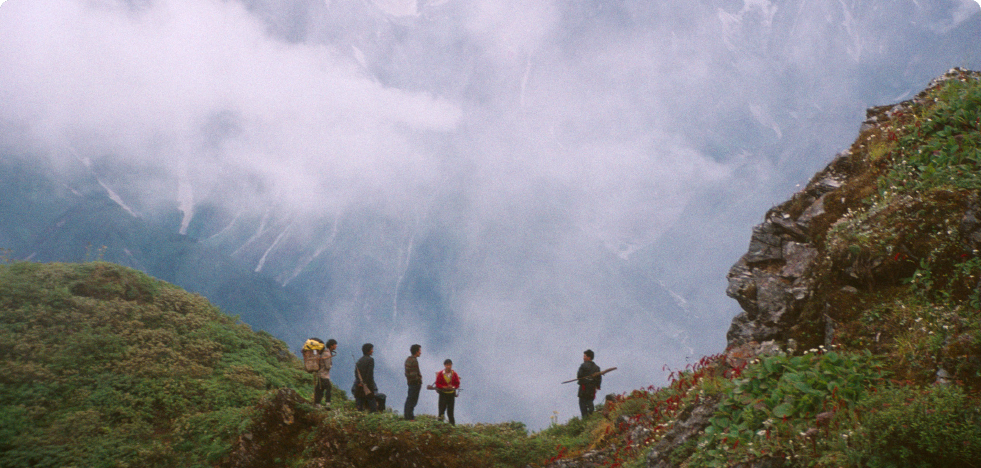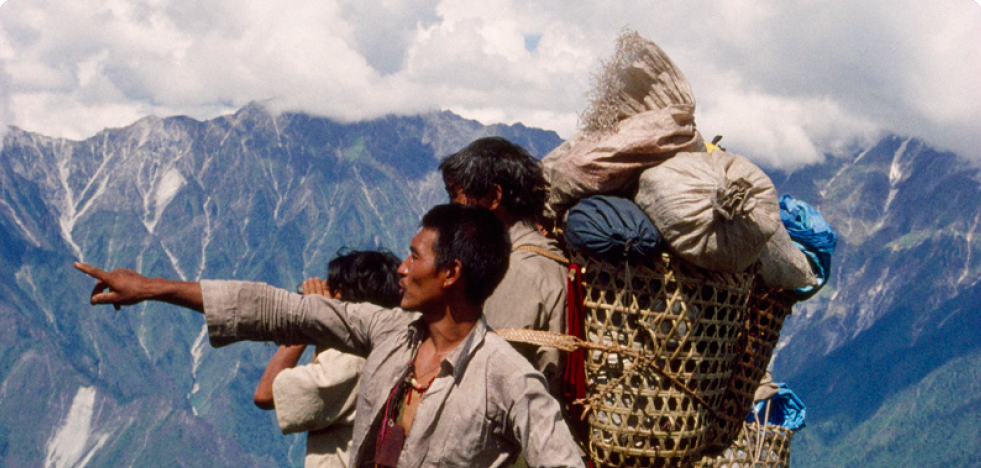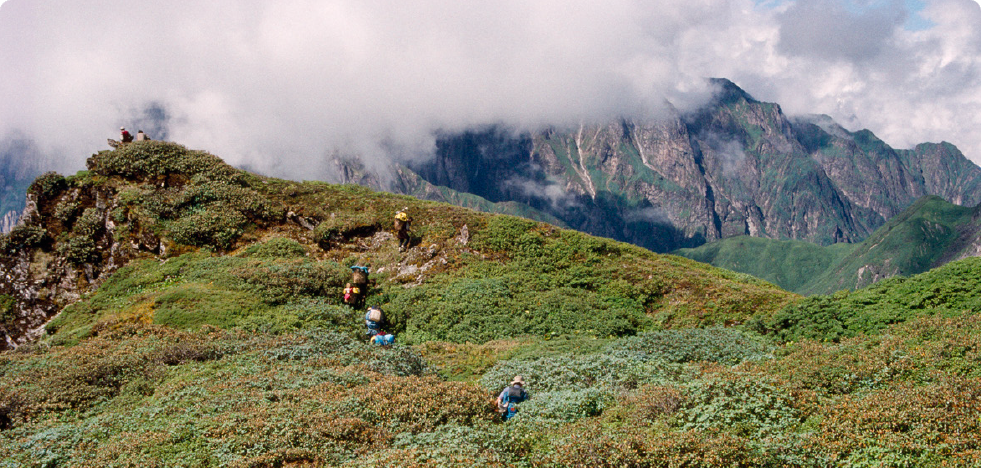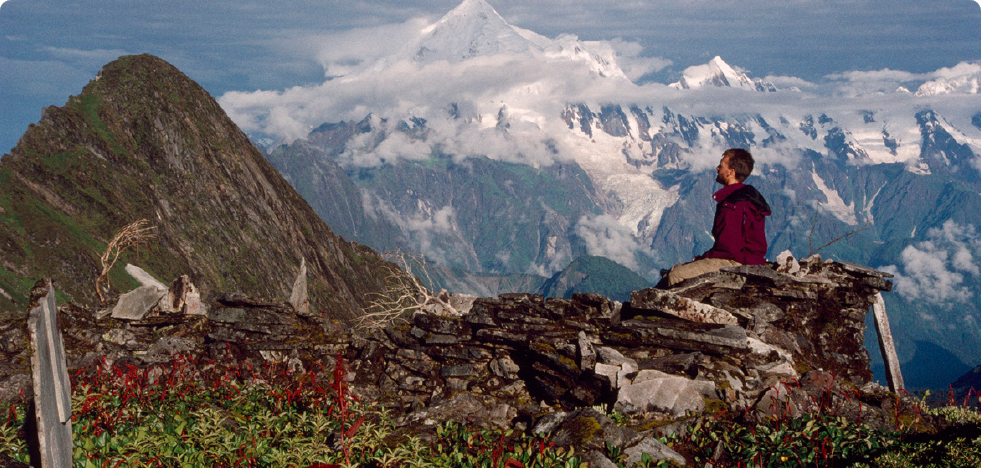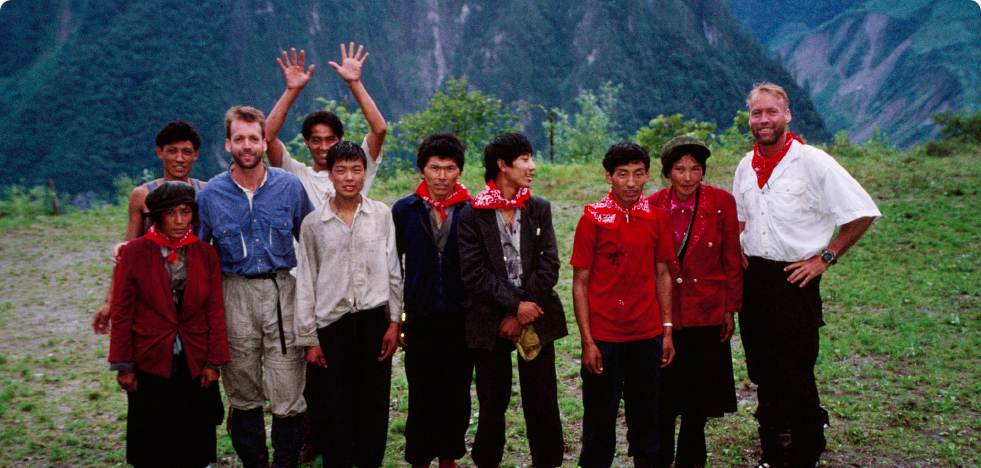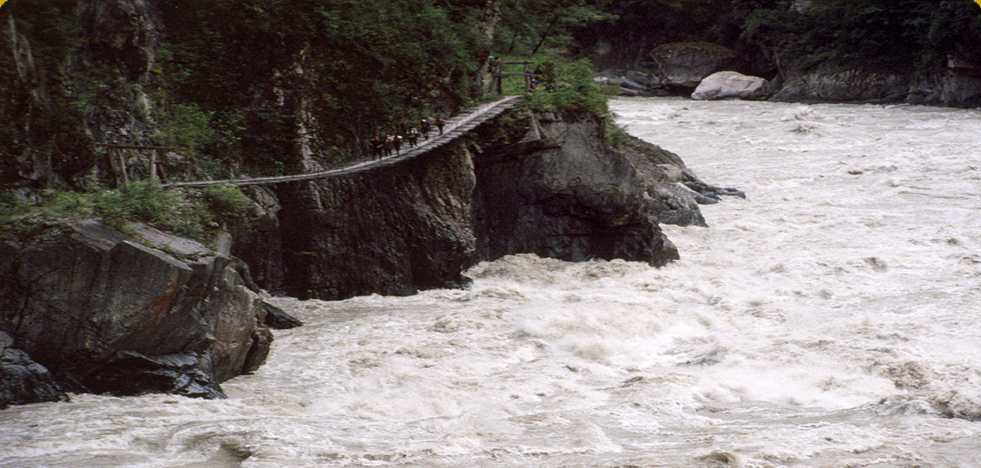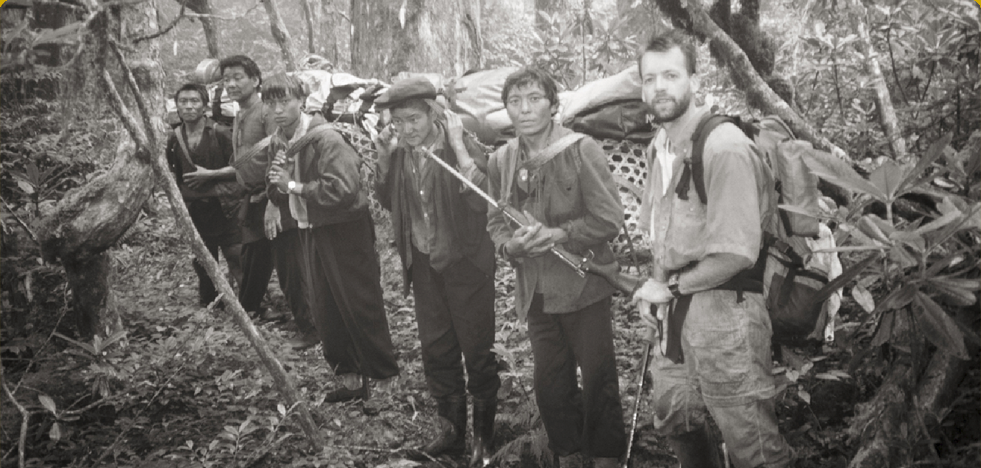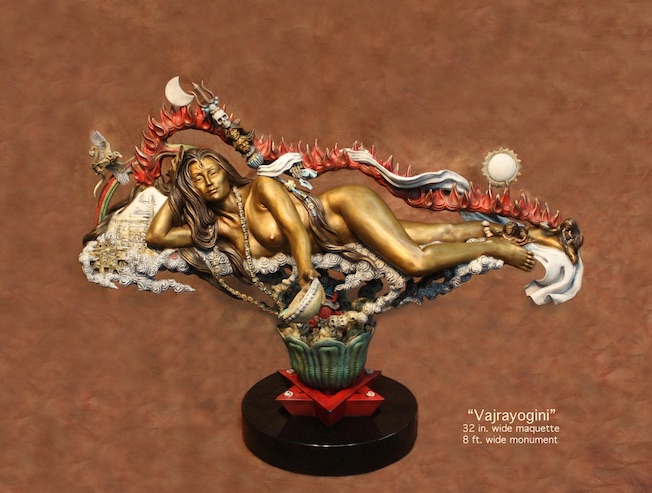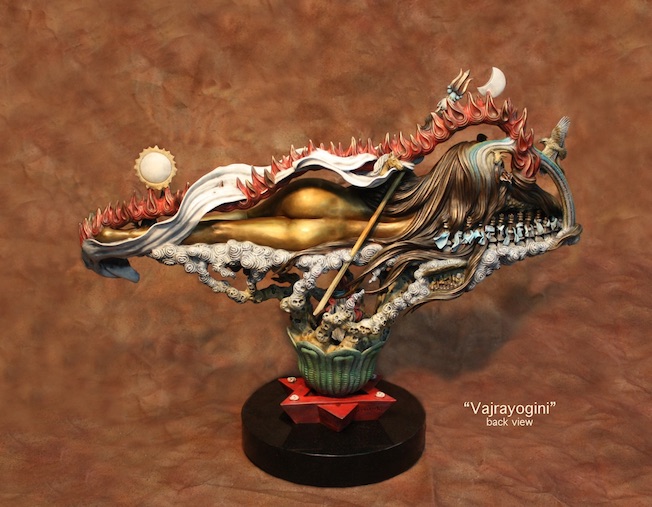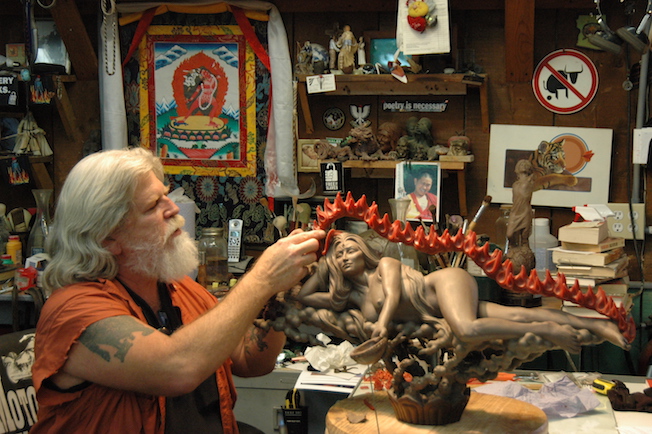
I have always been fascinated by the female energy and the intuitive and compassionate insights it has to offer. My interest deepened when my charitable work on the US/Mexico border introduced me to the venerated Virgin Guadalupe and her many enlightened attributes.
Likewise, my interest in Buddhism led me to Tibet for three ventures into the revered Beyul Pemako region – the “Hidden Land of the Blossoming Lotus”, the Shambhala of Tibet and the secret land of Vajrayogini. It was here that I was introduced to this female Buddhist meditational deity and her corresponding enlightened attributes.
Though existing on opposite sides of the planet, I was surprised and intrigued by the similarities of these two iconic female apparitions. Both offered divine guidance to their respective followers: Vajrayogini thru meditating upon, and incorporating within, her enlightened attributes, and the Virgin Guadalupe by praying to, and asking for, her external intervention. Even their symbolism is similar including flaming auras of their own radiant wisdom and both standing atop (representing overcoming) the evil forces of darkness and the afflictions of the human mind.
Due to Vajrayogini’s insistence that one’s reality is self-determined and can be altered thru meditation, I gravitated towards her teachings. Her practice deals with kundalini energies and is especially associated with the use of sexual passions to obtain enlightenment. She teaches us, not to repress passion, but rather to harness its power in a constructive way by transforming it into awareness and wisdom.
Historically, Vajrayogini has been sculpted, painted and described by monks – men of limited knowledge of the female body. Consequently, images like the one below don’t capture the allure of the female form. Invoking fear perhaps, but passion eludes them.
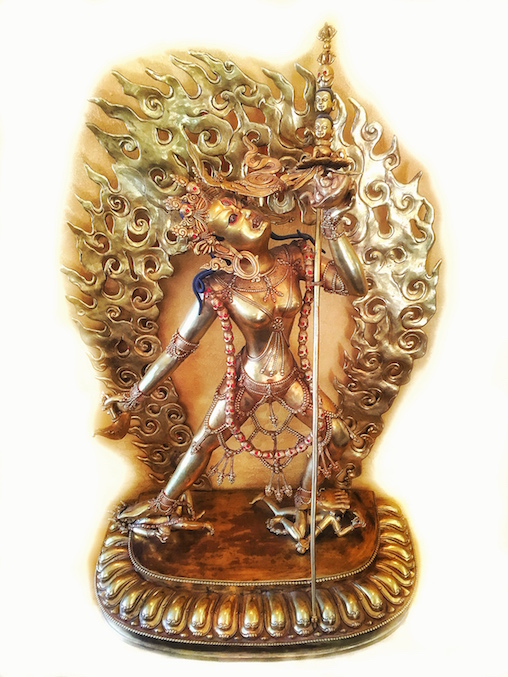
Vajrayogini is represented geographically spread out over the Pemako region (as further explained in the description below). In 1994, 1995 and 1997, we undertook month long, leech-infested and extremely arduous expeditions to Vajrayogini’s various terrestrial chakras. It was in 1995, during a particularly brutal portion of our trek to her heart chakra, the Kundu Dorsempotrang Mountain (the, All Gathering Home of the Vajrasattva Mind), that she revealed herself to me in a vision. However, instead of seeing her in the upright “Warrior Posture”, she had adopted the reclining posture of the Buddha. Also, instead of the stiff legged, rigid demeanor of a store-front mannequin (as depicted above), she was soft and supple and invitingly gorgeous. The Vajrayogini I saw was seductive – exuding power through her sexuality. The vision below was stamped indelibly.
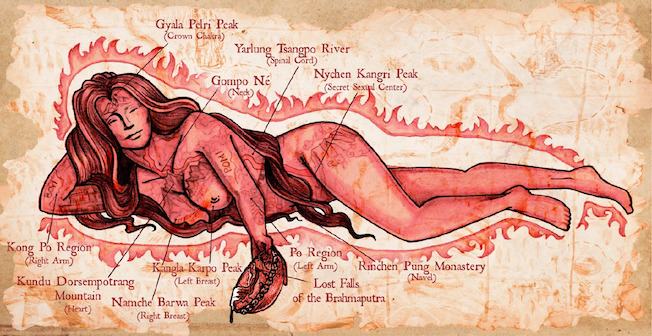 By: Catherine Gould www.cattgdesigns.com
By: Catherine Gould www.cattgdesigns.com
Pursuing my interest and deepening my understanding, I have since visited Vajrayogini pilgrimage sites in Nepal, India, Bhutan, Ladakh, Sri Lanka, Indonesia and on Mt Kailash. It has long been my ambition to find a way to convey my revelations, experiences and learning’s in a unique and meaningful way. My friend John Soderberg, a renowned artist and fellow Rancho Feliz “Guardian Warrior”, helped me do just that.
I commissioned John and for three years we worked on creating the “Reclining Vajrayogini” bronze. The piece is rich in symbolism and I know of no other sculptor who could so skillfully capture the essence of this enlightened being. I am convinced John was divinely guided. The Reclining Vajrayogini you see here is the self-same goddess who materialized before me in the waterfall mists of the Hidden Lands.
It’s important to note that the many Buddhist concepts symbolized in this sculpture exist independent of Vajrayogini. Likewise, we have incorporated several sacred sites and personal experiences into the piece. They are all explained below.
The “Reclining Vajrayogini” is a 75-piece, limited-edition, maquette-size bronze sculpture. She measures 25” tall and 32” long. In celebration of our upcoming book, the sculptor is offering the next two at a preview price of $14,500 each.
If you are interested please contact:
Gil Gillenwater
This email address is being protected from spambots. You need JavaScript enabled to view it.
Click to enlarge
Reclining Vajrayogini Symbolism
The "Diamond of Truth Practitioner"
(vajra = diamond-indestructible, yogini = female practitioner)
The "Lightning Bolt of Awareness Practitioner"
(vajra = lightning bolt-enlightenment, yogini = female practitioner)
Some of the descriptions below were taken from, “The Handbook of Tibetan Buddhist Symbols” by Robert Beer and correspondence and conversations with Hamid Sardar and Ian Baker.
Symbolism Links:
Vajrayogini
Kali
Sacred Landscape - Beyul Pemako
Vajrayogini’s Naked Body
Vajrayogini’s Reclining Posture
Celestial Throne of Clouds
Kalarati (Black God of Hatred) & Bhairava (Red Goddess of Desire)
Padma (Lotus Flower)
Dharmodaya (The Source of Vajrayogini’s Reality)
Flaming Aura
Surya (Sun) & Chandra (Moon)
Human Skull-Cup (Containing 5 Human Sense Organs)
Vajrayogini Eyes
Third Eye
Long Black Hair
Miniature Sow’s Head
Skull Necklace (50 Human Skulls)
Other Bone Ornaments
Kapala (Human Skull Cup or Bowl)
Kapala Vein Imprints (Lightning Bolt Pattern)
Kapala Waterfall & Mountains
Kartika (Ritual Flaying Knife)
Vajra in Sanskrit & Dorje in Tibetan (Ceremonial Object)
Khatvanga Staff
Knot of Eternity (Interdependence)
Scorpion
Rainbow
Garuda & Naga
Mt. Kailash
Mt. Kailash – Sky Burial
Mt. Kailash – Outer Pilgrimage Route
Cave of the 13 Golden Chortens (Stupas) – Inner Pilgrimage Route
Milarepa’s Cave - Zuthulphuk (The "Cave of Miracles")
Silver Palace
Author’s Note: The Tibetan Buddhist teachings described below can often be confusing and seemingly irrelevant to our lives. Concepts such as ”interdependence” and “emptiness” and the “void” are esoteric and often bewildering in the Western, linear, reason-trained mind. Simply put, the ultimate aim of Buddhism is “happiness.” Buddha realized it was not the exterior world that caused our unhappiness, but rather our own minds. Buddhism guides us to see our existence as it is, not as we wish it to be, with the inevitable unhappiness that arises when it doesn’t turn out as we imagined. This realization is “wisdom.” And Buddhism offers techniques and tools to gain this understanding. These techniques and tools are the “method.” And it is this recurring theme of “the union of method and wisdom” — the yin and the yang, male and female — that empowers us to create and influence our reality and our happiness.
Vajrayogini
Vajrayogini is a female Buddhist meditational deity or image. She is not a “God” in the conventional use of the word. She is an enlightened being as identified by her third eye. Meditational deities are often misunderstood as external gods or pagans to be prayed to and worshiped. In reality they are strictly symbols of enlightened principals - tools to help us gain awareness. They are reflections of our own inner enlightened potential - or what we can become. In meditation one can visualize himself/herself as having Vajrayogini’s enlightened attributes. Over time the brain’s neuroplasticity will allow the practitioner to digest and incorporate these attributes as his or her own.
While the tantric practice itself deals with all aspects of our daily life, the Vajrayogini practice is especially associated with the use of sexual energy for enlightenment and the transformation of ordinary desirous attachment or passion into wisdom. It works with the potent kundalini energies of the body. Mastery of the Vajrayogini practice purportedly confers fourth-dimensional paranormal abilities such as levitation, walking through solid matter, bi-locating, and so forth.
As a meditational deity, her purpose is to show us how to experience passion without trying to grasp it or be attached to it. She teaches us not to repress passion but rather to harness its energy to propel us to a realization of emptiness and its corresponding bliss. The highest tantras explain this transformational process as the poison of passion being cured by passion itself. In Tantric Buddhism all female consorts represent emptiness or the void and the wisdom thereof. And the male entity represents method or technique. This union of wisdom and method is a recurring theme in Tibetan Buddhism and one cannot exist without the other.
The Vajrayogini practice is particularly known for its ability to heighten intuition and to produce blessings during spiritually degenerated times. Tibetan Buddhism views Beyul Pemako as the hidden or secret land of Vajrayogini. Important Note: The Vajrayogini practices are considered esoteric and secret. Uninitiated engagement in these auricular teachings can have disastrous effects.
Kali
Many of Vajrayogini’s attributes flow historically from the Hindu Goddess, Kali (pronounced kah'lee). The name Kali is derived from Kala, the Sanskrit word for time. She therefore represents Time, Change, Power, Creation, Preservation, and Destruction. Kali is the Primordial Mother Goddess of Hindu tantric tradition. She has her origins in India's archaic matriarchal culture. She was originally a “Warrior Goddess,” worshipped with blood sacrifice and offerings of flesh and liquor. She was always viewed as all-powerful, as mysterious as night, fierce, passionately sensual and demanding. Yet to her worshippers she was always the all-merciful Protectress, filled with sublime love and compassion, a “Granter-of-Blessings.” Above all, Kali was, and still is, Kali Ma, "Kali the Mother", the Cosmic Female Power, always available for her devotees, ready to remove their suffering, their negative Karma, their fear of time (Kala) and death, always ready to bestow bliss and liberation. Kali's blessing is freedom, the freedom of the child to revel in the moment, and it is won only after confrontation or acceptance of death. To ignore death, to pretend that one is physically immortal, to pretend that one's ego is the center of things, is to provoke Kali's mocking laughter. This is why Kali and Vajrayogini are adorned with human skulls – constant reminders of one’s own mortality. According to tantric lore, the Goddess Kali is the highest expression of Goddess Power. She is the very essence of woman, sensual, pleasure-seeking, sometimes fickle, but in truth, nurturing. Like Nature, she can seem cruel, or can appear benign. She is the Dark Secret of the Universe, an initiatory power, the Ultimate Shakti. Within the body, she is the sexual Kundalini, the "Serpent Power", the key to liberation. In the world, she is all women, all Nature. She manifests simultaneously as virgin and whore.
Sacred Landscape - Beyul Pemako
Vajrayogini is represented geographically spread out over the Beyul Pemako (the “Hidden Land of the Blossoming Lotus”) region of southeastern Tibet as follows:
- Her head (crown chakra) is the 23,891-foot Gyala Pelri Peak (the “Glorious Peak”).
- Her throat is the innermost gorge of the Great Bend of the Yarlung Tsangpo River near Gompo Né (the “Sacred Site of the Protector”).
- Her spinal cord is the Yarlung Tsangpo River (the “Water Flowing from the Crest”).
- Her right arm is represented by the Kong Po region, including the city of Bayi and the Lama Ling Zangdhok Pelri Temple (the “Beneficent Copper Colored Mountain”).
- Her left arm is represented by the Po region that encompasses the town of Pomi and the Taksham Monastery (the “Tiger Skin Monastery”).
- Her right breast is the 25,436-foot Namche Barwa Peak (the "Blazing Mountain of Celestial Metal”).
- Her left breast is the 22,339-foot Kangla Karpo Peak. (the “White Palace”).
- Her heart is the Kundu Dorsempotrang Mountain (the “All Gathering Home of the Vajrasattva Mind”).
- Her navel is the Rinchen Pung Monastery (the “Mound of Jewels" or the “Precious Vase”).
- Her secret sexual center is the 22,386-foot Nychen Kangri Peak (the “Crystal Mountain”).
In 1995, brothers Gil, Troy & Todd Gillenwater participated in a pilgrimage which traveled to Vajrayogini’s heart chakra, her naval and along her spinal cord. The form or emanation Vajrayogini adopts in the Pemako region is that of the sow-faced Dorje Pagmo (Vajravarahi in Sanskrit). The sow represents ignorance in Tibetan Buddhism and many times a deity takes on the physical attributes of the emotion or state of mind that it has subdued or conquered. Hence, as the "patron goddess" of Pemako, Vajrayogini, has defeated dualistic ignorance with wisdom and taken on the head of the sow to become the deity Dorje Pagmo. In Buddhist symbology (and as seen on the Reclining Vajrayogini bronze), this same attribute can be depicted by placing a miniature sow’s head in Vajrayogini’s hair. (See, Miniature Sow’s Head Below.) Coincidentally, on the Tibetan calendar, 1995, the year of the Gillenwater’s expedition, was the "Year of the Pig".
Vajrayogini’s Naked Body
As a meditational deity, Vajrayogini is seen as having a naked 16-year-old body. She is radiantly beautiful and possesses a passionate nature. Her practice teaches us not to repress passion but rather to relate to it in a constructive way by transforming it into wisdom. Vajrayogini’s naked body symbolizes her freedom from ordinary conceptions and appearances. She is bronze in color, symbolizing the fierce arousal of desire and indicating Vajrayogini's ability to transform passion into the realization of emptiness and compassion. Her breasts are full and aroused, showing that she herself experiences great bliss and also that she bestows the attainment of great bliss upon practitioners.
Vajrayogini’s Reclining Posture
Though most often pictured in the upright warrior or archer stance (the Alidh Asana pose), as the ultimate seductress, this wrathful emanation of Vajrayogini has adopted the reclining posture. This is how Vajrayogini revealed herself in a dream to Gil during his 1995 pilgrimage into Pemako - and to her heart chakra. (See, Sacred Landscape, above.) Though reclining, Vajrayogini maintains the Alidh Asana pose with her outstretched right leg as a symbol of her method while her bent left leg is a symbol of her wisdom. This doubly reinforces the union of method and wisdom so vital to the practice of highest yoga tantra. This is an aggressive posture and it expresses the angry aspect of Vajrayogini. (See, Scorpion, below.) She adopted this wrathful form when she realized that her peaceful methods were too mild to subdue the degenerate beings in this age of darkness. In her infinite wisdom she decided a wrathful form would better able her to accomplish her compassionate intentions of protecting degenerate beings from the consequences of their own misguided behavior.
Celestial Throne of Clouds
In levitation, the Reclining Vajrayogini lies atop a floating celestial throne of swirling clouds. This lofty pedestal produces a deep state of meditative absorption. Reclining on this luxurious throne Vajrayogini is able to remain engrossed in a state of one-pointed-ness of mind with impeccable mental clarity and discernment.
In Buddhism our untrained mind is like a cloudy sky - in essence clear - but overcast by the clouds of deluded thinking. Delusions such as hatred, greed, and ignorance are not an intrinsic part of the mind. They are instinctive, impulsive thoughts designed for base survival and hardwired in our brains over hundreds of generations. The Reclining Vajrayogini’s superior position on top of the clouds tells us that she has overcome the mists of delusion through intense meditation. Just as the thickest clouds eventually disperse, so too even the strongest delusions can be removed from our mind. If we apply the appropriate methods they can be eliminated and we shall experience supreme happiness.
The clouds of Vajrayogini’s celestial throne are particularly meaningful in the practice of mindful-awareness meditation as taught by meditation master Chögyam Trungpa (1939-1987). Trungpa was trained in the Nyingma tradition (the oldest of the four schools of Tibetan Buddhism) and was a key teacher within the Kagyü lineage. According to his training, the meditation practitioner views his or her thoughts as clouds, possessing no intrinsic significance of their own. Meditation teaches us that thoughts can only hold sway if they are empowered by the thinker. Accordingly, during meditation the practitioner visualizes all emerging thoughts as clouds. Lacking the energy of the thinker’s validation, these thoughts drift in and out of form. And then a most consequential realization occurs, we understand that we don’t have to believe everything we think. This realization is liberating, releasing us from the bondage of our own deluded thinking.
Gil is a life-long student of Chögyam Trungpa’s teachings and he utilized Trungpa’s meditation practices in negotiating his way through Pemako on all three expeditions.
Kalarati (Black God of Hatred) & Bhairava (Red Goddess of Desire)
The Reclining Vajrayogini’s feet lie on top of two “worldly” gods who had strayed from the path of liberation. Once again this superior position symbolizes overcoming. Vajrayogini treads on Kalarati and his consort Bhairava to demonstrate that she has destroyed her attachment, hatred and ignorance and to show that she is free from the fears of samsara (cyclic suffering) and can lead all living beings to the same freedom. Her left foot is over Kalarati. Kalarati is black with four arms. He symbolizes hatred (ignorance) and Vajrayogini’s left foot over him represents that she has overcome this negative emotion through her practice. Kalarati’s consort is the goddess Bhairava. Bhairava is red with four arms. She symbolizes attachment (desire, lust) and Vajrayogini’s right foot lying on top of her represents that Vajrayogini has overcome this negative emotion through her practice.
Padma (Lotus Flower)
The Reclining Vajrayogini levitates above a lotus flower (padma). The lotus symbolizes purity and our ability to transcend our origins. Just as the lotus flower grows forth from the mud and scum at the bottom of the swamp – blooming beautifully, unsullied by the faults of the slime, so we have the potential to arise above our deluded thinking and afflictions of cyclic existence and gain lasting happiness through an understanding of the indivisible union of method and wisdom.
Dharmodaya (The Source of Vajrayogini’s Reality)
Below the lotus is a six-pointed star representing a three-dimensional hexagram. Composed of two interpenetrating equilateral triangular pyramids that point downward towards their unified point of origin, this hexagram or hexahedron represents the heart of the Reclining Vajrayogini’s celestial mandala abode – her celestial palace. This unified structure is often referred to as Vajrayogini’s reality source, or phenomena source, because it represents the ground from which she arose, from which she originated. In its three-dimensional mode, the gradual expansion of the hexagram as it ascends from its point of origin symbolizes the “gradual path” of the Vajrayana practice. The outer triangle symbolizes bliss and the inner one emptiness. Together they stand for the wisdom or knowledge that bliss and emptiness are indivisible. The six small equilateral triangles that form the corners of the Dharmodaya represent the six perfections: generosity, discipline, patience, effort, concentration and wisdom. In each of the four side corners are “wheels of joy” which twirl rapidly in a counter-clockwise direction and represent the “four joys.” The rapid swirls cause a sensation of great bliss to arise and descend throughout the body. The four levels of joy are known as joy, perfect joy, joy of cessation and innate joy.
Flaming Aura
An Aura is an energy field that is held to emanate from a god or goddess. It is an arc or circle of radiant, luminous light or glory around the body of a sculptured divinity. The Reclining Vajrayogini is surrounded by a flaming aura of her own radiant wisdom.
Surya (Sun) & Chandra (Moon)
Situated on the upper right of the Reclining Vajrayogini’s aura, the Surya is the Hindu sun god. In Buddhism it is depicted with the moon to represent the basic unity in the apparent opposition between relative (or conventional) truth – and absolute knowledge, or truth. Situated on the upper left of Vajrayogini’s aura is the Chandra, or moon sickle. In Vajrayana Buddhism it symbolizes the complementary aspects (or unity) of opposites.
Human Skull-Cup (Containing 5 Human Sense Organs)
Below the Reclining Vajrayogini is a human skull-cup offering bowl containing the five human sense organs emitting flames. This symbolizes the way our ordinary five sensory experiences can be “burned-up” or transformed, by the wisdom of understanding emptiness, from being factors of imprisoning us in samsaric dissatisfaction into the very nourishment fueling our journey along the path. (In keeping with the tantric belief of not suppressing the senses, but rather skillfully utilizing them, to propel one to enlightenment.)
Vajrayogini Eyes
The Reclining Vajrayogini's gaze is slightly upward, direct, and penetrating, demonstrating her power to guide serious practitioners directly to enlightenment. This upward gaze also indicates Vajrayogini’s proactive role in creating her own reality through training her mind. She takes personal responsibility for her happiness. Her gaze is not downward, indicating the submissive or subservient attitude of a victim.
Third Eye
The Reclining Vajrayogini has a third eye. This distinguishes her as an enlightened being and symbolizes her enlightened ability to see the past, present and future simultaneously. The third eye also represents the Reclining Vajrayogini’s six-sense ability of “intuition.” The Vajrayogini practice offers techniques to help develop one’s intuitive capabilities. Here intuition is deemed a mental state between the Universal mind and one's individual, discriminating mind. It is the door through which we can pass into the fourth dimension – the dimension of a conscious, intelligent, abundant and interconnected universe.
On their 1997 expedition, brothers Troy and Gil and two young Sherpas, Dawa Yakpa Lama and Bhim Bahadur Mahar (and subsequently Ken Storm), split from the main expedition and traveled unpermitted, without maps and without benefit of mobile phones or GPS devices into Beyul Pemako, Vajrayogini’s homeland and one of the most hostile, unknown and unforgiving environments on the planet.
Facing seemingly insurmountable odds, they relinquished logic and control - for in those environs there were none. They embraced Vajrayogini’s spiritual essence and traveled on intuition alone, secure in the trust of a sixth-sense divine guidance. Defying all logic, coincidence after fortuitous coincidence led them on the journey of a lifetime, “The Rainbow Traverse of the Great Bend of the Yarlung Tsangpo.” That journey culminated in Gil and Troy locating the long-sought “Lost Falls of the Brahmaputra” - one of the Earth’s last undiscovered features.
Long Black Hair
The Reclining Vajrayogini’s hair is dark black. Since black hair cannot be dyed the way lighter hair can, it symbolizes the unchanging nature of truth or absolute knowledge as opposed to subjective or relative knowledge. It is free-flowing and waist-length, symbolizing her freedom from the fetters of self-grasping.
Miniature Sow’s Head
The Reclining Vajrayogini (Dorje Pagmo in Pemako) has a small sow’s head implanted over her right ear. In most illustrations, Dorje Pagmo is shown with the head of a sow clearly emanating from her head, indicating her identity. This symbolizes her overcoming the ignorance of a hog. With an unenlightened mind, the pig is guided by self-interest alone, consuming whatever comes in front of its snout. Never analyzing consequences, it simply follows its nose, trapped in its own sense-driven, myopic worldview. (See: Sacred Landscape, above.)
Skull Necklace (50 Human Skulls)
Around the Reclining Vajrayogini’s neck is a garland of 50 human skulls. Since they hang from her neck, or throat, they represent her 50 purified inner winds - the purity of her speech. The 50 skulls also represent the 16 vowels and the 34 consonants of the Sanskrit alphabet. The skulls also represent the female principle of emptiness. These skulls are bleached and dry, indicating the fierce arousal of inner heat or “tummo” in the Vajrayogini practice. This passionate heat has the ability to burn and “dry up” all mental distortions, causing ordinary mindsets to transform into pure wisdom.
Other Bone Ornaments
Buddhist iconography is full of skeletons, bones, corpses and the like. Proximity to death, Buddhists believe, deepens our awareness of our own impermanence and grounds us more firmly in reality. Accordingly, the Reclining Vajrayogini is adorned with various human bone ornaments symbolizing the first five perfections making up the method aspect of the path: head ornaments represent effort; ear ornaments represent patience; neck ornaments represent generosity; heart ornaments represent mental stabilization or meditative concentration; and the ornaments of the arms and legs represent perfection of moral discipline. Her body itself represents the sixth perfection, wisdom. And so, through her wearing these bone ornaments the union of method and wisdom is indicated once again.
Kapala (Human Skull Cup or Bowl)
Skull bowls are used in tantric rituals for offering sacrificial blood to protective deities to ensure their devotion - a holdover from the Bön religion. This represents awareness, clear light consciousness and the joy of the lama who once occupied the skull. This spiritual ambrosia has been digested by the Reclining Vajrayogini and unified with her penetrating wisdom. The skull bowl contains the essential elixir of insight into the void; when full of blood, it represents the purification of egotism. In the Reclining Vajrayogini bronze, the Kapala (skull cup) also holds the Beyul Pemako region of southeastern Tibet. Pemako is a land uniquely sacred to the Tibetan people - a region they describe as the ultimate place of pilgrimage and a "celestial realm on earth.” At the same time this remote border region is one of the least known parts of the planet. It is here that the tantric goddess, Vajrayogini, is represented geographically. (See: Sacred Landscape - Beyul Pemako above and Kapala Waterfall & Mountains below.)
Kapala Vein Imprints (Lightning Bolt Pattern)
The vein imprints inside the skull signify obstacles that affected the former occupant during his or her lifetime. Positive marks in the skull demonstrate the qualities of the deceased. The lightning bolt pattern of the positive marks has special symbolic significance in Tibetan Buddhism. Buddhists believe that we live our lives in a dream. Like characters in a movie, we are actors in the drama that is our everyday reality. And because these dreams are authored by our impulsive behaviors and deluded thoughts, we become victims in our own tragic dramas. Accordingly, the number one truth in Buddhism’s seminal Four Noble Truths is that life is suffering. Buddhism strives to wake us from this dream and remind us of who we really are. Its teachings show us the real context of all that is "out there" in the external world so that we can regain our true identity as the observer of our thoughts and not their hapless victim. Symbolically the Vajra (see: Vajra in Sanskrit & Dorje in Tibetan (Ceremonial Object), below) represents the “lightning strike” that rouses us from our dream states. This is called “enlightenment.” It’s that change in human consciousness—a pivotal episode in the lives of mystics and saints. Once "enlightened," the observer can detach from relative “likes” and “dislikes” and the personal importance of money, romance, food and even life itself. Happiness then comes from inside - not outside - of the observer who recognizes that he or she is not a victim in life’s circumstantial drama but rather an active part of its creation.
The lightning bolt pattern of the positive marks also represents the colossal lightning and thunderstorm that brothers Gil, Troy and Todd Gillenwater witnessed during their 1995 pilgrimage. At the base of Vajrayogini’s heart chakra, the sacred Kundu Dorsempotrang Mountain, brilliant flashes and ear-splitting claps went on for hours. The wrathful Pemako Gods were flexing their power with a vengeance.
Kapala Waterfall & Mountains
Gil and Troy Gillenwater’s three expeditions into Beyul Pemako (joined by brother Todd in 1995) are artistically represented inside the skull cup. This includes the 1994, first decent, rafting trip down the Yarlung Tsangpo River – Tibet’s most sacred river and Vajrayogini’s spinal chakra; the 1995, pilgrimage to Vajrayogini’s mystical heart and naval chakras; and the 1997, pilgrimage to the “Million Lives” Tsebum site, and exploration of the fabled “Inner Gorge” – Vajrayogini’s throat chakra. In addition, Gil and Troy’s “The Rainbow Traverse of the Great Bend of the Yarlung Tsangpo” culminated in their locating the long-sought “Lost Falls of the Brahmaputra” – one of the Earth’s last undiscovered features.
Kartika (Ritual Flaying Knife)
In the Reclining Vajrayogini’s right hand she holds a curved flaying knife marked by a vajra or dorje (see below) symbolizing the wisdom that has cut through ignorance. The vajra represents the path or method and the knife (kartika) symbolizes the disintegration of all matter and all worldly bonds and their transformation into a positive force. This is also the knife used in “sky burials”. (See: Mt. Kailash – Sky Burial, below.)
Vajra in Sanskrit & Dorje in Tibetan (Ceremonial Object)
The Reclining Vajrayogini bronze has a vajra (dorje in Tibetan) situated on the handle of the flaying knife (kartika) held in her right hand. Originally the symbol of the Hindu Vedic god Indra, the vajra is known as the “Thunder Bolt”. (See: Kapala Vein Imprints (Lightning Bolt Pattern) above.) The vajra encapsulates the meanings, “lightning strike” as maximum active energy and “diamond” or “adamantine” as the densest most indestructible material. These two principals destroy all manners of ignorance. The vajra symbolically represents the male principal of “method” as the source of the creative seed. The vajra is to the Buddhists as the lingam is to the Hindus.
Khatvanga Staff
Supported on the Reclining Vajrayogini’s left shoulder is a khatvanga staff. This represents her consort Heruka Chakrasamvara. Its presence indicates that he and Vajrayogini are inseparable as the union of female wisdom and male method. The khatvanga is octagonal in cross-section, symbolizing the eight great charnel grounds of Heruka’s mandala. Heruka Chakrasamvara is also known as the horse-headed Hayagriva in Tibetan Buddhism. On the Reclining Vajrayogini, Hayagriva is represented by a miniature horse head suspended on a thread near the khatvanga at the back of the bronze statue. This further symbolizes the union of the male and female principles.
The top of the khatvanga staff consists of (bottom to top) a crossed-vajra symbolizing the union of wisdom and compassion; a golden vase, also known as the “Vase of Inexhaustible Treasures” symbolizing the spiritual abundance of the Buddha; and a freshly severed head, a decaying head, and a dry skull. These three severed heads symbolize the conquest of the three poisons of desire, hate and ignorance, respectively. And at the very top of the staff is a flaming trident. Carried over from the Hindu religion, the trident represents the “triad of existence” – the constant change of becoming, being and disintegration. From the crossed-vajra and vase hangs a long silk ribbon symbolizing touch and hanging threads, or strings, which bear the emblems of a sun and moon (symbolism described above) and a bell. The hollow of the bell represents the female aspect, the void from which all phenomena arise, including the sound of the bell. The clapper represents the male aspect of method or form. Together they symbolize wisdom (emptiness) and compassion (form or appearance). The sound, like the triad of all phenomena, arises, radiates forth and then dissolves back into emptiness. There is also a small Knot of Eternity attached to the other hanging thread. This “Endless Knot” is further described below.
Knot of Eternity (Interdependence)
The “Knot of Eternity” is a Tantric Tibetan symbol at the very core of Buddhist belief. This ancient geometric design represents the true nature of reality - where everything is interwoven and interdependent. Nothing exists independently. Nothing exists “on its own.” This seemingly paradoxical principle is also referred to as “dependent arising.”
It was poignantly demonstrated to Gil in 1995, in Kathmandu, Nepal. There he had an audience with the Tibetan Buddhist Lama, Chokyi Nyima Rinpoche. Following their introduction and requisite offerings of respect, the Rinpoche (teacher) asked Gil to grab a chair. With five people and only four chairs he motioned for Gil to get another… but he wouldn’t say the word.
“Chair?” Gil asked.
“Oh, is that what it is?” Chokyi questioned in his distinct Tibetan accent.
“Yes of course.” Gil exclaimed, thinking that perhaps he just couldn’t remember the word in English.
As Gil dragged the extra chair over to their semi-circle, Chokyi looked puzzled and asked him, “Are you sure it’s a chair?”
“Sure I’m sure,” Gil answered a little amused.
“I see”, said Chokyi nodding his shaven head. “Well, tell me,” he continued, “what part of that is the ‘chair’? Is it the four wooden legs?”
“No, it’s not just the legs.” Gil answered.
“The metal seat?”
“No.”
“The padded back? - Where is this ‘chair’ you are telling me about?”
“Well, it’s all of the pieces put together - that’s the chair.” Gil answered, beginning to realize he might be wading into an academic sinkhole.
“So all of those pieces go together to make up the chair. Is that right?”
“Yes, that’s right.” Gil exclaimed, and continued, “It’s the ‘concept’ of a chair.”
“I see,” said Chokyi, feigning perplexity. He then continued, “So the ‘chair’ is the sum of its parts and it exists by itself. It exists independently, just like you do. Is that right?”
“Yes.” Gil said. He stood and picked up the chair and shook it. “This is a chair.”
What’s his damn point? Gil thought to himself.
“Hhmm… that’s interesting.” Said Chokyi. “Let me ask you something. Could the ‘chair’ exist here today if someone hadn’t made it?”
“No.” Gil answered.
“So, what you’re calling a ‘chair’ is dependent on the sum of its parts plus the man who produced it. Is that right?”
Gil was beginning to realize that he was screwed but he had no choice but to go along for the ride. “I think I see what you mean.” he answered, not too sure.
“What about the tree that supplied the wood for the legs? Is the ‘chair’s’ existence dependent on that?”
“Well yes…” Gil began to agree but Chokyi cut him off.
“And the woodcutter who sawed down the tree for the wood - and the mother who gave birth to the woodcutter - and the people who grew the food that nourished the mother during her pregnancy - and the saw that cut down the tree - and the men who mined the metal from which the saw was made - and the tires on the truck that hauled the wood to the lumberyard - and the fuel that ran the truck’s engine - and the tree that dropped the seed from which this tree grew - and the spring rains that watered it, and the generations of dead animals and vegetation that decayed into compost to nourish the tree - and the sun’s life sustaining rays - and the “big bang” that created the sun…”
Suddenly he stopped and Gil realized that this exercise - what the Buddhists call Dependent Origination or Dependent Arising - could literally go on forever.
“Would the ‘chair’ exist here today if any one of the before mentioned components were left out?” Chokyi asked.
“No, I guess it wouldn’t.” Gil answered - his mind obviously spinning.
“Let’s take it a step further.” Chokyi continued. “The components or ‘things’ that make up the chair are themselves in a constant state of becoming, being and disintegrating. So these ‘things’ that appear so solid are in reality nothing more than a collection of relationships and events. A more realistic view of reality would be to see the world as an interdependent and interrelated, never beginning and never ending ‘process.’ Ours is a world of events rather than things.
But by habit you picked out a few key features and labeled it a chair. You believed in your concept of a chair so strongly that it is all you saw. You were convinced that the ‘chair’ existed on its own - or as we say - ‘from its own side.’ The independent chair was your conventional reality.
"But as we just saw from our little discussion - the ultimate reality of the chair is that it is connected to - and dependent upon - everything in the universe. It is ‘process,’ empty of inherent existence. Its solidity, its independent existence - if you will - is an illusion.”
So everything is ‘process’ and ‘empty’ of inherent existence.” Gil stated. He turned this over and over in his mind and it was starting to make sense. Gil’s long-held belief that things existed independently - especially “me” - is a conventional reality. The ultimate reality is that he - and everything else - only exist in relationship - an unbounded, interdependent and interconnected web of causality.
As Gil looked around the room with this new awareness he saw that nothing existed except ongoing, interconnected, process.
So ended Gil’s introduction to “emptiness.”
It’s revealing to try this dependent-arising exercise on oneself and our own existence. Despite what our ego would have us believe, we are not in fact separate, independent and “self existing” beings. Rather we only exist in relation to, and are dependent upon, everything else as strands in a universal web of cause and effect.
This intrinsic inter-connectedness is symbolized by the infinite single thread design of the “Endless Knot.” Interdependence is a recurring theme in Buddhist philosophy. With this awareness we understand the true nature of our own human experience - we do not exist independently. And in this respect we matter, for we are cause in the fabric of life and every action we take affects the whole. With this globular understanding comes the realization that the best thing we can do for ourselves is to take care of each other. This non-dualistic awareness, that our own liberation is inexorably bound with those we serve, is the guiding philosophy behind the Rancho Feliz Charitable Foundation, Inc., a charity Gil founded in 1987: http://www.ranchofeliz.com/ Gil has labeled this, “enlightened self-interest” and he chose the Knot of Eternity to be the charity’s logo.
The Knot of Eternity also represents the “illusory nature of time.” Yet another recurring theme, Buddhists believe that chronologic time is simply a human construct devised to help explain consequence – or karma.
Scorpion
A red scorpion is positioned below the Reclining Vajrayogini’s right arm, yet she remains calm and unfazed. In Pemako, in addition to Vajrayogini’s sow-faced emanation of Dorje Pagmo, she also has a wrathful manifestation known as Kludulma (pron. Ludulma) – Klu = naga (a naga is a snake or serpent representing the unenlightened spiritual forces of the underworld), dul = tamer, ma = female - “the female tamer of serpents.” The natural environment of Pemako is so remote and wild with vipers, tigers, landslides, scorpions, lightning storms, etc., that Vajrayogini had to take on a wrathful form to subdue the powerful negative forces. By this process she was able to transform the fear and superstition of the indigenous Bön religion into a Buddhist philosophy dedicated to cultivating wisdom and compassion. Kludulma is often depicted holding a scorpion in her right hand. This represents her overcoming fear and its constricting limitations. The scorpion in close proximity to the Reclining Vajrayogini is red in color. This red signifies danger and a threat to life. Yet rather than running or denying her fear, she utilizes its energy to overcome and move beyond it. This is a true “tantric” method. Negative forces – which are all rooted in fear – are not to be repressed and denied, rather, they are to be recognized, involved, and utilized in the process of their own self-destruction. As Vajrayogini employs the power of passion to transcend passion, so she utilizes the energy of her fear to transcend her fear. She uses the negative poison of the scorpion to turn in on and destroy itself. By having the courage to actually allow the scorpion next to her – the Reclining Vajrayogini shows that she is the “tamer” or “liberator” of negative forces (our five gross senses) – forces that keep us hopelessly trapped in our habitual cycles of ignorance and suffering. Wholeness is realized when we learn to acknowledge our fears and walk through them.
Rainbow
In the Nyingma Buddhist tradition Vajrayogini is often associated with rainbows. Her practice instills the power to melt one’s body into rainbow light at the time of death and transport it to the land of the Dakinis. (See, Silver Palace, below.) In addition, rainbows are always auspicious. The Reclining Vajrayogini’s rainbow, soaring over Mt. Kailash on the front of the bronze and melding with her hair at the back, has special significance to Gil, Troy and Todd. At the beginning of their 1995 expedition/pilgrimage to Vajrayogini’s heart chakra, in a crackdown, the Communist Chinese Police (Public Security Bureau) detained and confiscated their Tibetan monk guides. Not sure of the trailhead, the group drove to the Takshim Monastery in hopes that the Lama there would be familiar with the trail. Explaining their dilemma, the Lama ushered them into the main temple where he conducted an exceptional form of divination known as a "prasena", from which a clear vision was to come. Chants were sung, drums were beaten, symbols clashed, and potions in a human skull cup (see description above) were passed around. Abruptly the ceremony ceased and the Lama motioned them outside. Upon leaving the Temple they saw the most magnificent rainbow running across the sky and down into the second valley on the horizon. The Lama smiled and they knew that was the beginning of their hike, Dashing Valley. Pemako had spoken.
Garuda & Naga
On the Reclining Vajrayogini bronze the Garuda is featured soaring inside the rainbow above Mt. Kailash. In both Hindu and Buddhist mythology a Garuda is a large mythical bird or bird-like celestial being. It represents the soaring awareness of the enlightened mind. It is most often depicted with a snake (naga) in its beak or claws. Nagas (Tibetan - Klu) - are negative subterranean beings that dwell in water or underground. Classified as animals they often appear in a serpent-like form. They represent the unconscious, unaware or unenlightened mind. By the Garuda subjugating the snake it represents the supremacy of the enlightened mind over the unenlightened mind.
The Garuda is significant to Gil since one appeared to him on Mt. Kailash. When he finally gained the lofty Cave of the 13 Golden Chortens (19,600 feet), directly above him soared a magnificent celestial hawk.
On the reclining Vajrayogini the Garuda is holding its hands over its heart chakra in the namascar position. This indicates the Garuda is holding a precious gem between its palms. The gem represents the sangha, or the community of Buddhist practitioners. The Garuda also has special significance to Gil because of its identical appearance to the eagle holding the serpent on the Mexican flag. And it is in Agua Prieta, Mexico that Gil founded the Rancho Feliz Charitable Foundation, Inc. in 1987: http://www.ranchofeliz.com/ Gil credits his many trips to Tibet and his study of Tibetan Buddhism as a major influence in his decision to devote a large portion of his life to serving the underprivileged. Gil took his bodhisattva vows directly from His Holiness Tenzin Gyatso, the 14th Dalai Lama in 1993. So to Gil the gem held between the Garuda’s palms also represents his sangha of Rancho Feliz volunteers and the Mexican people they serve. According to Gil, he owes the Mexican people a huge debt of gratitude for providing him an arena in which he can diminish his ego through service to others – a concept at the very core of Buddhist teachings.
In addition, the Naga is particularly meaningful to Gil and his brothers Troy and Todd. On their 1995 expedition they hiked ahead of the group and came upon a most beautiful mirror-clear river. Not having bathed in days they decide to strip down and dive in. When the tribal Monpa porters arrived they were horrified to see the brothers in the water. Evidently these were most sacred waters and their swimming indicated the ultimate disrespect. Bad karma was sure to follow. The Gillenwater’s didn't think much of the incident. They should have. The next day Todd got violently ill. Two days later Troy and Gil became hopelessly sick. The brothers were so ill that they barely made it out alive. This was no surprise to the Monpa porters. They were convinced the brothers were visited by Nagas while in the consecrated waters.
Mt. Kailash
The Reclining Vajrayogini is pillowed by Tibet's Mt. Kailash. In 2007, Gil trekked through the Karnali Valley from Nepal into Tibet. The journey followed an ancient shaman’s path through the western Himalayas, trekking through remote villages where Tibetan traditions have survived intact amidst precipitous gorges and soaring peaks. Visible from some distance, this massive pyramid of rock rises regally above the arid plains. The mountain is father to four of Asia’s great rivers; the Yarlung Tsangpo/Brahmaputra, the Indus, the Sutlej and the Karnali. Many consider the sacred mountain to be the heart center of our planet - a staircase linking Heaven and Earth. To Buddhists, Mt. Kailash represents the father-mountain, the active male principal of skillful means – of method and action. And the nearby serene Lake Manasarovar represents the mother-lake or the passive female principal of wisdom – the understanding of interdependence and non-inherent existence (fundamental emptiness). Accordingly, Buddhists associate Mt. Kailash with the tantric meditational deities, Chakrasamvara and his consort Dorje Pagmo (Vajrayogini). Depicted most often in sexual embrace, these tantric deities represent the purified aspects of human nature – particularly of wrathful or passionate aspects which might ordinarily cause great suffering but which, if properly transformed through spiritual training, may lead one to true wisdom and happiness.
Mt. Kailash – Sky Burial
There is a sky burial site depicted on the Reclining Vajrayogini’s, Mt. Kailash. Here on a granite outcropping above the Tarboche flagpole, bodies are chopped to pieces and fed to vultures. Vajrayana Buddhism teaches the transmigration of spirits (reincarnation). Therefore after death there is no need to preserve the empty body vessel. However, as the departed Buddhists’ last compassionate act they give their bodies to feed other living creatures. In 1997, it was here that Gil participated in a bizarre and rather eerie “Death” ritual conducted by a half-crazed Bön shaman. (Bön is the ancient and animistic religion that pre-dates, and is a precursor to, Tibetan Buddhism. Bön shamans are experts in rituals concerning the control of powerful spirits, death and burial, exorcism, divination and other occult matters.) Lying on the blood-soaked stone, surrounded by human bones and body parts, Gil visualized his own death and was ushered step-by-step by this mystical adept through his ultimate release into the Bardo. The term Bardo means, “intermediate state” and to Tibetan Buddhists it refers to the transitional wait between death and rebirth. For Gil this was a profound experience and another powerful lesson in impermanence and change – concepts so fundamental to Tibetan Buddhist philosophy.
Mt. Kailash – Outer Pilgrimage Route
At the base of the Reclining Vajrayogini’s, Mt. Kailash is the 32-mile circumambulation, or outer kora. It is traveled by Buddhists and Hindus clockwise, while Bön-Po’s (those practicing the indigenous religion of Tibet) circle counter-clockwise. Some devotees perform full prostrations, taking months to inch-worm their way around the hallowed mountain. For over two thousand years pilgrims of various faiths have made the arduous journey to Mt. Kailash. They come seeking transcendence and merit by circling the mountain’s base (the 22,028-foot peak is sacred and has never been scaled). Every year approximately 20 pilgrims die from the extreme conditions that the outer kora demands.
On the bronze, the small figures circumambulating the mountain represent man’s evolution of consciousness. Some symbolize man in his animal state, looking out for himself at everyone else’s expense. This existence is one of chaos and fear. We see people in great competition to get ahead. Tightly bound in their deluded thinking of independent selves, many are fighting and holding each other back. We see man’s inhumanity, exploiting others in their desperate attempts to advance their own causes. There is little compassion as the figures stand on one another and even try and pull each other off the sacred kora. Yet for some the chaos has diminished and a sense of reflection has emerged. There is an evolutionary force at play – an urgency – a need to advance and break free from the quagmire of human suffering. Man’s shared humanity is realized. Some figures we see caring and nurturing others. There is a spirit of cooperation as the figures help one another along the kora to enlightenment. These compassionate figures symbolize the realization that it is in man’s own best interest to help his fellow man. “Enlightened Self-Interest” is born.
Gil made this holy circuit in addition to completing the fabled inner kora and arduous climb to the lofty Cave of the 13 Golden Chortens (see below). His journey corresponded with the annual festival of Saga Dawa when, on the full moon of May, an enormous flagpole laced with countless multi-colored prayer flags is raised to commemorate the anniversary of Buddha's birth, enlightenment and death. Thousands of pilgrims were gathered with great ritual and fanfare to replace the prayer flags on the gigantic pole. In addition, hiking the kora on this auspicious date multiplied the merits of one’s actions a thousand fold. This was the starting point for Gil’s three-day outer kora around the heavenly mountain. The additional merit earned Gil’s group rare access into the secret and hidden inner kora (see below).
Cave of the 13 Golden Chortens (Stupas) – Inner Pilgrimage Route
On the Reclining Vajrayogini bronze the “Cave of the 13 Golden Chortens” is located behind the Reclining Vajrayogini’s head. In addition to its outer kora, Mt. Kailash offers a secret and secluded inner kora. This inner kora contains the world’s highest Buddhist shrine, the Cave of the 13 Golden Chortens. This sacred site is virtually inaccessible to all but the most intrepid pilgrims. Located on Mt. Kailash's overhanging southern wall, this celestial site is perched nearly 20,000 feet high. The 13 shrines are filled with relics, scriptures and the bones of Buddhist saints. They represent stages on the path to enlightenment and they mark one of the oldest - and highest - pilgrimage sites in the world. For hundreds of years fearless devotees have braved the perilous journey seeking passage to other worlds. Gil and his group traveled up the Seralung Valley to begin the treacherous and seldom-traveled inner pilgrimage. Sheer trails provided high-risk access. Along the way they were subjected to a steady barrage of rock and ice hurtling from the sacred summit – whizzing by as though shot from a gun. Having gained the grotto and its treasured chortens, Gil strung prayer flags. Surrounded by the bones and relics of saints long since departed, he was bathed in the reality of change and impermanence. When Gil asked an aging Buddhist monk if he thought it would be possible for him to climb to the 13 Chortens he was told, "They are the treasures of Kailash. Whether you can reach them or not depends not on the weather, snow or ice but on your own karma."
Milarepa’s Cave - Zuthulphuk (The "Cave of Miracles")
On the Reclining Vajrayogini bronze Milarepa’s Cave is located at the back under the Cave of the 13 Golden Chortens. Milarepa is generally considered one of Tibet’s most famous yogis and poets and a major figure in the history of the Kagyü school of Tibetan Buddhism. The essence of Milarepa lies in his emphasis on the temporary nature of the physical body and the need for non-attachment. He retreated to the "Cave of Miracles" on Mt. Kailash for years of intense meditation. Milarepa’s Cave is capped by a large slab of rock, said to be impressed on its underside with the shape of Milarepa’s hands, shoulders and upper back. Surrounding the boulder and the temple complex are dozens of stacks of Mani Stones, rocks carved with prayers and quotations from Buddhist scriptures. It is said that Naro Bönchung (the Bön priest who sought to deny Buddhist newcomers access to the mountain) hurled this boulder at Milarepa in the midst of their legendary contest of magical powers. Milarepa caught it and placed it down gently above his meditation cave. During this contest Milarepa defeated the Bön priest Naro Bönchung and the Bön priest was forced to leave Kailash. In 2007, Gil entered Milarepa’s Cave and saw the fabled ceiling slab of stone with the imprints of Milarepa’s hands, shoulders and upper back. “My religion is to live - and die - without regret.” – Milarepa
Silver Palace
On the Reclining Vajrayogini bronze the Silver Palace is located on the far left front, just under Mt. Kailash. In 2007, Gil explored the Silver Palace in the lost Kingdom of Zhangzhung – pronounced “yangyung”. This is an expansive region in western Tibet located three and a half miles above sea level and encompassing an area larger than the states of Texas and California combined. Zhangzhung was the ancestral homeland of the bird-horned kings who once reigned from the splendor of the Silver Palace over twelve centuries ago. The Silver Palace is located in Khyunglung, the ancient cave city capital of Zhangzhung. Khyunglung and the Silver Palace are located in the Khyunglung Valley, (also known as the Garuda Valley) through which flows the Sutlej River, one of Asia’s four great rivers. (All four rivers have their source on the flanks of nearby Mt. Kailash.) Once the lifeblood of this large ancient civilization, the river’s waters supported over 30,000 cave dwellers from 1,500 to 3,000 years ago. The Garuda Valley also contains the venerated Vajrayogini hot springs.
The Silver Palace and its caves were originally inhabited by practitioners of the Bön religion. (The Bön religion pre-dates, and is a precursor to, Tibetan Buddhism.) These were religious functionaries, expert in the rituals concerned with the control of powerful spirits, death and burial, exorcism, divination and other occult matters. The caves of the Silver Palace are located high on the mountainsides. These lofty grottos were important power points in the ancient Bön religion. They linked heaven and earth and were endowed with powerful cosmogonic, theogonic and genealogical associations becoming the very “souls” of particular areas. Buddhism arrived in the region in the 7th century and soon overtook and displaced the Bön religion. Until very recently historians believed that Tibet derived its culture and spirituality entirely from India. However, it is now understood that much of Tibet’s culture and spirituality came from a strong indigenous, non-Indian culture and spiritual traditions that flourished in the ancient pre-Buddhist kingdom of Zhangzhung. Scholars now believe that Tibetan Buddhism’s “old school” Dzogchen (translated “The Great Perfection”) teachings originated in the lost Kingdom of Zhangzhung. The highest attainment on the Dzogchen path is to meditate with such intensity that one transforms into a “Body of Light” or rainbow. Consequently, rainbows are depicted throughout the ancient cave drawings and paintings in this area. In addition, crystals, with their prism capabilities to transform sunlight into rainbow light, were often used in sacred ceremonies. In 2007, during his exploration of the vast cave networks constituting the Silver Palace, Gil found one of these divine crystals. Its size is that of a baseball.

